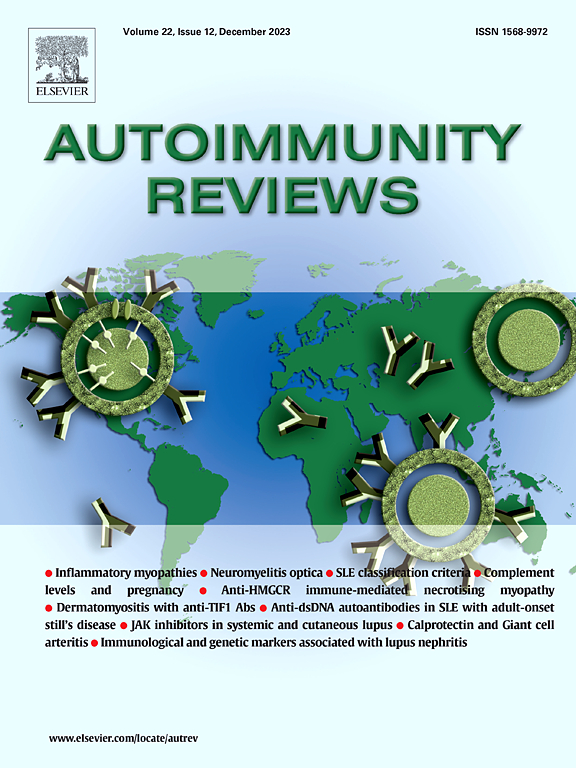结缔组织病相关间质性肺疾病的动物模型:现状和未来方向
IF 8.3
1区 医学
Q1 IMMUNOLOGY
引用次数: 0
摘要
间质性肺疾病(ILD)对结缔组织疾病(CTD)死亡率有显著影响。尽管存在治疗ctd相关ILD (CTD-ILD)的指南,但由于两个关键因素,许多患者对治疗的反应不佳:(1)对亚型特异性致病机制的理解不完整,(2)依赖于系统性硬化症或非肺类风湿性疾病的治疗,这些治疗未能解决不同CTD-ILD亚型的独特病理生理。这阻碍了个性化治疗,并强调了对准确复制疾病特异性机制的强大临床前模型的需求。然而,挑战仍然存在:(1)缺乏充分捕捉这些疾病异质性的模型;(2)尽管最近实验方法取得了进展,但缺乏系统的结构化综述来指导模型选择。这些问题往往导致研究目标与模型效用的不匹配。本文综述了目前的CTD-ILD动物模型,重点介绍了它们的构建、特点和局限性,并强调了每种模型与相应人类疾病之间的差异。我们总结了这些差异,并提出了新兴技术,包括CRISPR/ cas9介导的基因组编辑、人源化小鼠和肺类器官/肺芯片系统,这些技术可能促进下一代模型的发展。通过整合现有的和新兴的策略,我们的目标是为模型的选择和开发提供指导,促进精确建模,加速靶向治疗的发现,最终改善临床结果。我们强调开发特定亚型模型的重要性,以避免“一种模型适合所有”的方法。本文章由计算机程序翻译,如有差异,请以英文原文为准。

Animal models for connective tissue disease-associated interstitial lung disease: Current status and future directions
Interstitial lung disease (ILD) significantly contributes to connective tissue disease (CTD) mortality. Although guidelines for managing CTD-associated ILD (CTD-ILD) exist, many patients respond poorly to treatment owing to two key factors: (1) incomplete understanding of subtype-specific pathogenic mechanisms, and (2) reliance on therapies adapted from systemic sclerosis or nonpulmonary rheumatic diseases, which fail to address the unique pathophysiology of distinct CTD-ILD subtypes. This hinders personalized treatment and underscores the need for robust preclinical models that accurately replicate disease-specific mechanisms. However, challenges remain: (1) the lack of models that fully capture the heterogeneity of these disorders and (2) the absence of systematic structured reviews to guide model selection, despite recent advancements in experimental methodologies. These issues often result in mismatches between research goals and model utility.
This review summarizes current CTD-ILD animal models, focusing on their construction, characteristics, and limitations, and highlighting differences between each model and the corresponding human disease. We summarize these disparities and propose emerging technologies, including CRISPR/Cas9-mediated genome editing, humanized mice, and lung organoids/lung-on-a-chip systems, that may facilitate the development of next-generation models. By integrating established and emerging strategies, we aim to provide guidance for model selection and development, promote precision modeling, accelerate targeted therapy discovery, and ultimately improve clinical outcomes. We emphasize the importance of developing subtype-specific models to avoid a “one-model-fits-all” approach.
求助全文
通过发布文献求助,成功后即可免费获取论文全文。
去求助
来源期刊

Autoimmunity reviews
医学-免疫学
CiteScore
24.70
自引率
4.40%
发文量
164
审稿时长
21 days
期刊介绍:
Autoimmunity Reviews is a publication that features up-to-date, structured reviews on various topics in the field of autoimmunity. These reviews are written by renowned experts and include demonstrative illustrations and tables. Each article will have a clear "take-home" message for readers.
The selection of articles is primarily done by the Editors-in-Chief, based on recommendations from the international Editorial Board. The topics covered in the articles span all areas of autoimmunology, aiming to bridge the gap between basic and clinical sciences.
In terms of content, the contributions in basic sciences delve into the pathophysiology and mechanisms of autoimmune disorders, as well as genomics and proteomics. On the other hand, clinical contributions focus on diseases related to autoimmunity, novel therapies, and clinical associations.
Autoimmunity Reviews is internationally recognized, and its articles are indexed and abstracted in prestigious databases such as PubMed/Medline, Science Citation Index Expanded, Biosciences Information Services, and Chemical Abstracts.
 求助内容:
求助内容: 应助结果提醒方式:
应助结果提醒方式:


